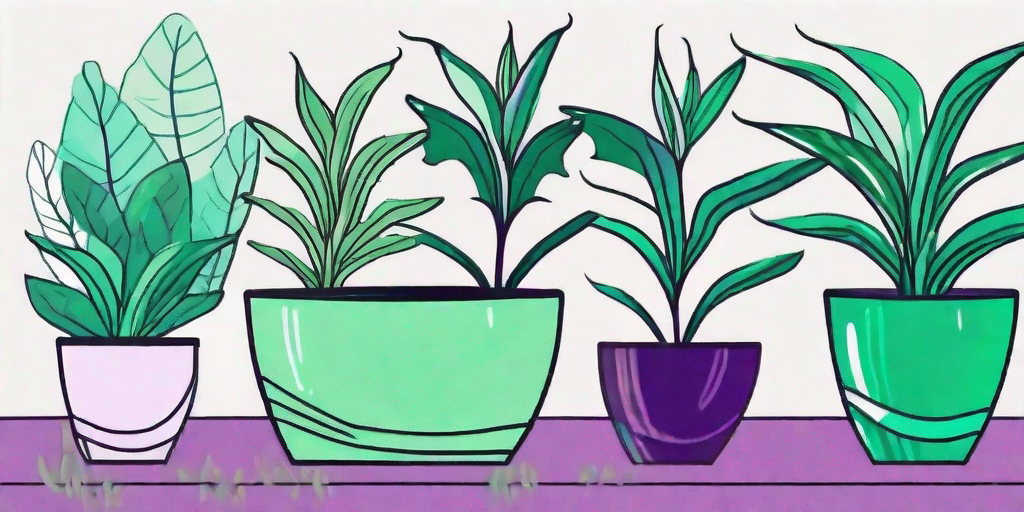
The Dragon Tongue plant, also known as the 'Mother-in-law's tongue' or 'Snake plant', is a captivating houseplant that is known for its hardiness and striking appearance. With its long, sword-like leaves and vibrant color patterns, it's no wonder that this plant has earned such a mythical name. But don't worry, it doesn't breathe fire. At least, not that we know of.
Introduction to the Dragon Tongue Plant
Originating from West Africa, the Dragon Tongue plant (scientific name: Sansevieria trifasciata) is a member of the Asparagaceae family. This plant is a favorite among both beginner and expert gardeners due to its low maintenance requirements and its ability to purify the air. Yes, you heard it right. This plant is a literal breath of fresh air.
But what makes the Dragon Tongue plant truly stand out is its unique appearance. The long, upright leaves are green with greyish patterns, and the edges are tinged with a bright yellow. The leaves grow from a rosette, giving the plant a dramatic, architectural look. It's like having a mini skyscraper in your living room.
How to Grow a Dragon Tongue Plant
Choosing the Right Pot
Before you start growing your Dragon Tongue plant, you need to choose the right pot. The plant prefers a pot that is wider than it is deep, as it has a relatively short root system. A pot with drainage holes is a must, as this plant does not like to have wet feet. And by feet, we mean roots.
When it comes to the material of the pot, you can choose between plastic and terracotta. Plastic pots retain moisture for longer, while terracotta pots are porous and allow the soil to dry out faster. If you're the type of person who forgets to water their plants, a plastic pot might be a better choice. But if you're a serial over-waterer, go for terracotta.
Planting the Dragon Tongue
Once you've chosen the perfect pot, it's time to plant your Dragon Tongue. Fill the pot with a well-draining soil mix, such as a combination of potting soil, perlite, and sand. Place the plant in the pot, making sure that the top of the root ball is level with the soil surface. Then, fill in the gaps with more soil, pressing it down gently around the base of the plant.
After planting, give your Dragon Tongue a good drink of water. But remember, this plant is more of a 'sip and savor' type, not a 'guzzle and gulp' type. Overwatering can lead to root rot, which is as unpleasant as it sounds.
Caring for Your Dragon Tongue Plant
Light Requirements
Dragon Tongue plants are pretty flexible when it comes to light. They can tolerate low light conditions, but they really thrive in bright, indirect light. So, if you have a sunny window, that's the perfect spot for your Dragon Tongue. But if you don't, don't worry. This plant won't hold a grudge.
One thing to note is that too much direct sunlight can scorch the leaves, causing them to turn yellow or brown. If you notice this happening, move your plant to a shadier spot. After all, no one likes a sunburn.
Watering and Feeding
As we mentioned earlier, Dragon Tongue plants are not big drinkers. In fact, they prefer to be slightly under-watered than over-watered. A good rule of thumb is to let the top inch of soil dry out before watering again. And when you do water, make sure to water thoroughly, so that water runs out of the drainage holes.
When it comes to feeding, Dragon Tongue plants are not very demanding. A general-purpose houseplant fertilizer applied once a month during the growing season (spring and summer) is more than enough. During the winter, you can cut back on feeding, as the plant's growth slows down.
Common Problems and How to Solve Them
Brown Tips
If the tips of your Dragon Tongue plant's leaves are turning brown, it could be due to low humidity or overwatering. To increase humidity, you can place a tray of water near your plant or mist the leaves with water. If overwatering is the issue, reduce your watering frequency and make sure your pot has good drainage.
Yellow Leaves
Yellow leaves can be a sign of overwatering or too much sunlight. If your plant is getting too much water, let the soil dry out before watering again. If it's getting too much sun, move it to a spot with less direct light.
FAQs about Dragon Tongue Plant
- Is the Dragon Tongue plant toxic?
Yes, the Dragon Tongue plant is toxic if ingested. Keep it out of reach of pets and children.
- How often should I repot my Dragon Tongue plant?
Dragon Tongue plants prefer to be slightly root-bound, so you only need to repot every 2-3 years.
- Can I propagate my Dragon Tongue plant?
Yes, you can propagate your Dragon Tongue plant by division or leaf cuttings.
In conclusion, the Dragon Tongue plant is a versatile and attractive houseplant that is easy to care for. Whether you're a seasoned plant parent or a newbie, this plant is sure to bring a touch of magic to your home.















